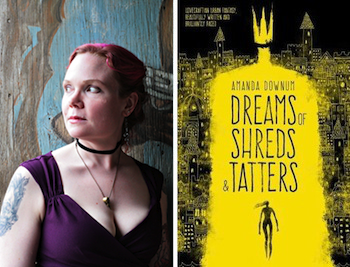Amanda Downum’s most recent novel, Dreams of Shreds and Tatters (out now from Solaris Books), is a book I unexpectedly loved. Downum has previously written an excellent trilogy, the Necromancer Chronicles, which I can also highly recommend.
Today she’s joined us to talk about unpronounceable cults, nightgaunts, and the difference between writing contemporary and second-world fantasy.
LB: Let me start rather generally, by asking your opinion of how women—whether as authors, as characters, or as fans and commenters—are received within the SFF genre community. Have you seen change over the time you’ve been involved in the field?
AD: I’m not sure how much of what I notice is change in the community or simply my growing awareness of issues in the field. I pay more attention to those conversations now. I think discussions of gender, race, and sexuality are more prominent than they were a decade ago, and more focus is placed on representation and challenging tropes. Which in turn makes those who feel threatened when their tropes are challenged respond more loudly.
LB: So Dreams of Shreds and Tatters, your latest novel, is a bit of a departure from your earlier three. The Drowning City, The Bone Palace, and Kingdoms of Dust all took place in a secondary world. Dreams takes place mostly in Vancouver, and its fantasy elements partake of a good measure of Lovecraftian creepiness. Were there any big differences in writing Dreams from the other three?
AD: Worldbuilding is tricky in different ways in contemporary settings. You can rely on modern language and cultural references and are less likely to get bogged down figuring out how the plumbing works—I definitely know more about Erisin’s sewer system than I do Vancouver’s, or Austin’s. But setting a book in a real city, especially one in which I don’t live, is nerve-wracking. I researched and visited and asked locals for advice, and I’m still certain I made all kinds of silly little mistakes that will make readers familiar with the city roll their eyes. With any luck they’ll be distracted by nightgaunts and ghouls.
LB: So, Dreams of Shreds and Tatters is clearly influenced by Lovecraft (as far as this Lovecraft-ignoramus can tell, anyway). Tell us about your – and your novel’s—relationship with Lovecraft?
AD: I’ve been exposed to Lovecraft’s influence since high school, if not earlier, through writers like Roger Zelazny, Brian Lumley, and Caitlin R. Kiernan, but I didn’t read his own work until after college. I think that was the best time for me to do so, to appreciate the awe and horror of an inimical cosmos, and humanity’s insignificance therein. I was also old enough to recognize all the racism.
Many of the tropes I play with in Dreams–some seriously, others more lightly—owe less to the particular writings of Lovecraft or Chambers or Bierce, and more to the greater Mythos that’s accreted around their stories
LB: Would you like to expand a bit on the tropes you’re playing with in Dreams?
AD: Unpronounceable cults. Unspeakable oaths. People confronted with horrors not meant to be witnessed by humanity. I’m interested in the decisions and desires leading up to those oaths, and while autodefenestration is a convenient way to end a short story, I think most people have different coping mechanisms when faced with horrible things.
LB: Next question! What writers or artists, in your opinion, have had the largest influence on you? Tell us a little about them.
AD: In the past fifteen years I think it’s been Caitlin R. Kiernan, Elizabeth Bear, and Barbara Hambly, who give me graceful and engaging prose, stories with the weight of myth and unsettling resonance of dreams, clever mysteries, and love stories to and for monsters. Neil Gaiman and Clive Barker are also lasting influences, for similar reasons.
LB: What should your readers look for from you in the future? Will there be more stories in the world of Dreams of Shreds and Tatters?
AD: I hope to write more about Liz and Blake eventually, but have no immediate plans for a sequel. I’m also working on another book that explores different corners of the same world. The majority of my short fiction takes place there as well–I’m still looking for a sexy name for the universe.
LB: Thank you for joining us!
Liz Bourke is a cranky person who reads books and occasionally watches things. Her blog. Her Twitter.










